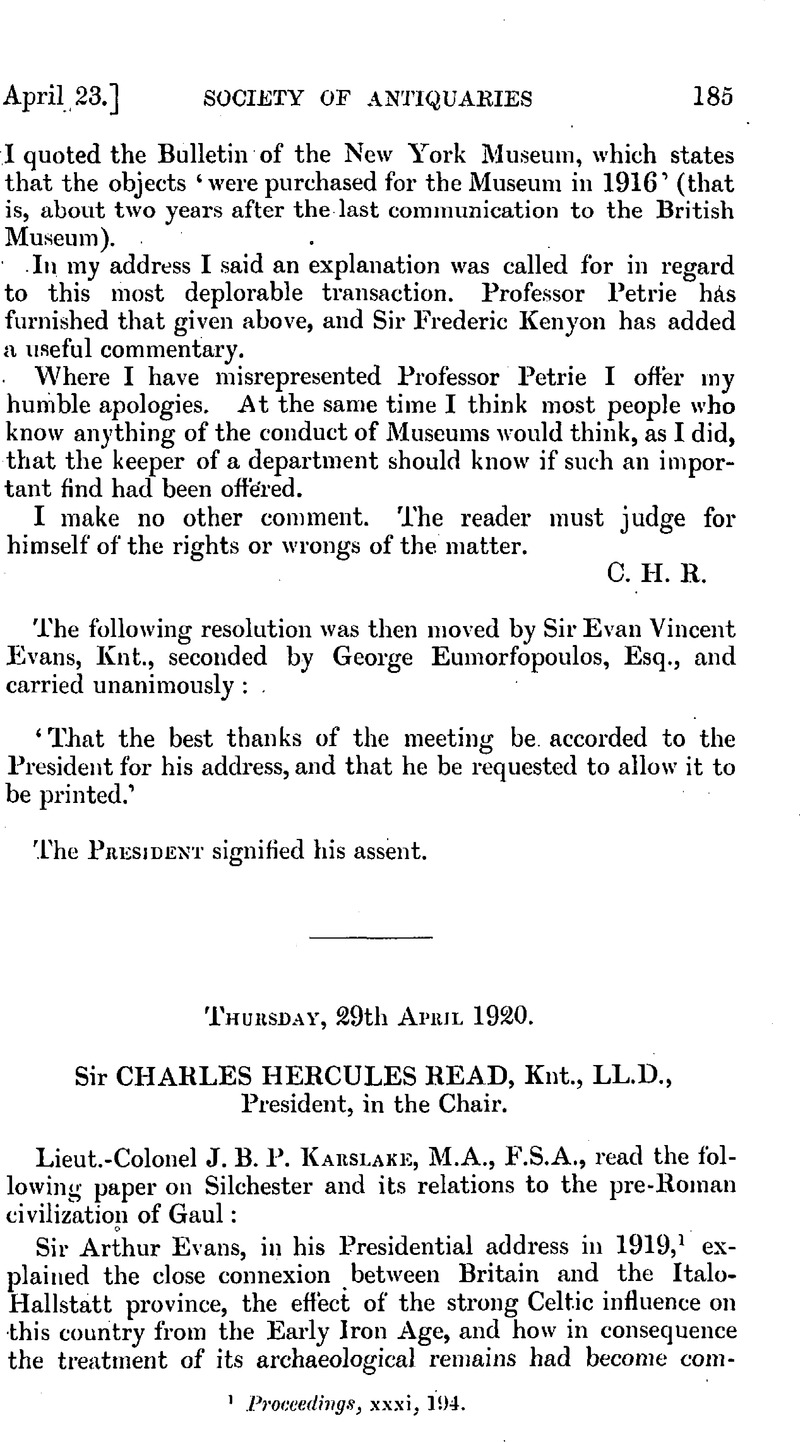No CrossRef data available.
Article contents
Thursday, 29th April 1920
Published online by Cambridge University Press: 23 March 2011
Abstract

- Type
- Proceedings
- Information
- Proceedings of the Society of Antiquaries of London , Volume 32 , Issue 1 , June 1920 , pp. 185 - 201
- Copyright
- Copyright © The Society of Antiquaries of London 1920
References
page 185 note 1 Proceedings, xxxi, 194.
page 186 note 1 Owing to the small scale this road is only shown roughly in fig. 1. It in fact closely follows the line of the counterscarp of the ditch.
page 189 note 1 ‘Ban-leuca. Tractus ut plurimum unius leucae seu miliaris intra quem civitas seu monasterium potest bannum exercere.’— Amis, , Diet. Med. Latin., Paris, 1886Google Scholar.
‘La banlieue était ainsi appelée parce qu'elle comprenait ordinairement le terrain qui contournait le chef-lieu de la juridiction jusqu'é une lieue environ de distance, mais dans une foule de localités elle était ou plus grande ou plus petite … La banlieue de Paris était plus de deux lieues aux environs.’ —Larousse, s.v.
page 190 note 1 Les Enceintes romaines de la Gallic, p. 277.
page 191 note 1 Silchester must have remained at least for many years after the Roman occupation in the position of civitas peregrina, and as such retained its national institutions (Lavisse, Histoire de France, I. ii. 209). Fragments of three inscriptions found on the site record a collegium pereyrinorum civitatis Callevae, a corporation or electoral body of peregrini by and from whom the magistrates of the city were chosen. The Roman citizenship was not conferred on all inhabitants of the empire till the Edict of Caracalla (A. D. 212–17), and cf. Fustel de Coulanges, La Gaule romaine, p. 88.
page 192 note 1 supra p. 190.
page 192 note 2 It may well be that the portoria are perpetuated in the name Portway, applied from early times to the Roman road which connected Silchester and Old Sarum.
page 192 note 3 Caesar, B. G. viii. 48.
page 193 note 1 Lavisse, Histoire de France, I, ii, 170.
page 194 note 1 p. 227, no. 80, and Dallaway, Hist. of Sussex, vol. i, 9.
page 194 note 2 Ballard, British Borough Charters, 170, and see law of Wihtraed of Kent quoted in Baldwin Brown, Arts in Early England, vol. i, p. 81.
page 195 note 1 Birch, Cart. Sax., V, i, 69.
page 195 note 2 Hasted, Kent, vol. iv, p. 401.
page 195 note 3 Appendix, Municipal Corporations' report, 1835.
page 196 note 1 D. B., i, 2, Larking, Domesday of Kent, 90.
page 196 note 2 Camden, Britannia, ed. 1695, p. 198 ; Baldwin Brown, Arts in Early England, i, 166 ;Archaeologia, lxvi, 384.
page 196 note 3 The present entrance is called Longport Street, a name which comes down from early medieval Canterbury.
page 197 note 1 Hasted, Kent, vol. ii, 308.
page 197 note 2 The leucata is found in Saxon England. Athelstan granted jurisdiction round St. Wilfrid's church at Ripon for a leuca ‘on ilke side ye kyrk a myle’ (V. C. H. Yorkshire, ii, 214). ‘In Ripum Leuga S. Wilfridi totū circa ecc'lm i leuga’ (D. B. i, fol. 303).
page 197 note 3 There can he little doubt that the Sussex rapes preserve this idea of the measuring line or ‘rope’. Thus the Lowey of Pevensey is also styled a rape ; and the leucata granted to Battle abbey by the Conqueror is also termed the abbot's rape. That the leucata was a recognized adjunct to many English cities in the eleventh century, cf. Dialogus de Scaccario, 73. 1. v, 15, xxi, A 15, ed. Hughes, Oxford, 1872.
page 197 note 4 Cf. Kemble, Saxons in England, i, 97.
page 198 note 1 Oxford Diet., s.v.
page 199 note 1 Memoires, 1648, bk. 5, chap. 15, p. 386. Quoted in Dict. Larousse, s.v. Arras.
page 200 note 1 W. Z. Ripley, Races of Europe, p. 243.


